Your cart is currently empty!
INTERVIEW | YINZHU YAO
Yinzhu Yao is a dynamic architectural designer whose expertise is shaped by a broad and diverse background, spanning multiple countries and disciplines. Her educational journey began with a Bachelor of Architecture from Suzhou University of Science and Technology in China, where she built a solid foundation in architectural theory and design. She then advanced her studies with a Master of Architecture from Washington University in St. Louis, a program that expanded her technical skills and exposed her to cutting-edge architectural practices.
Professionally, Yinzhu has honed her craft at some of the most prestigious architectural firms around the globe. Now as a Technical Designer at Gensler in Washington, D.C., she plays a crucial role in high-stakes projects that demanded both creative ingenuity and technical precision. Her experiences at Sou Fujimoto Atelier in Tokyo and Kengo Kuma & Associates provided her with unique insights into innovative design philosophies, reinforcing her belief in the power of architecture to harmonize functionality with aesthetic beauty.
Her commitment to excellence and innovation is also evident in her active participation in international design competitions. Yinzhu has garnered numerous accolades, including Gold and Silver awards at the MUSE Design Awards and recognition as a Gold winner in Global Future Design Awards, as well as winners of various international competition, such as Special Mention in Reuse the Fortress — Villeneuve: Architecture Competition held by Reuse Italy, etc. These achievements underscore her ability to push the boundaries of traditional design and her dedication to continually refining her craft.
Besides work, Yinzhu is also a talented photographer and artist. She believes that art is a universal language, and her keen aesthetic sense and expressive abilities have allowed her to excel across these creative fields. Her photography work has been recognized at the prestigious 2024 IPA International Photo Awards, where she received an Official Selection in the professional category, as well as Gold Winner of Global Photography Awards.
Her work has been showcased in prominent international exhibitions, including the University of Pennsylvania Museum of Archaeology and Anthropology, the Beijing 798 Art Zone, and Isolart Gallery in Florence. Yinzhu’s piece “AFTERMATH IN TRIPOLI” was selected for the “On the Critical Point: Wanderlust and Nostalgia in the New Age” exhibition at Penn Museum, where it was one of only 18 works chosen from over 300 submissions. Her diverse portfolio, which spans architecture, photography, and conceptual design, has earned her global recognition for her contributions to exhibitions like the OFA WORLD AWARD in Beijing and the “Reuse the Fortress” competition in Villeneuve, Italy.

Yinzhu Yao – Portrait
https://yyz-creative.framer.website
____________________________________________________________________________________________________________
Yinzhu’s design philosophy centers on creating spaces that are innovative, sustainable, and deeply connected to their cultural and environmental contexts. She is committed to designing environments that not only meet the practical needs of their users but also enhance their quality of life. Her work often reflects a balance between simplicity and sophistication, with a focus on sustainability and cultural relevance. There is a famous ancient Chinese saying that goes, “Establish the heart for heaven and earth, establish the destiny for humanity, inherit the knowledge of past sages, and bring peace to all generations.” She deeply resonates with this message. It speaks to how young people should strive to contribute to society. She believes that in any creative endeavor in architecture, we must carry a heart filled with compassion, seek to solve social problems, and make meaningful contributions to our precious historical heritage and disadvantaged groups. Only then can the world become a better place, and the knowledge we acquire can be fully utilized.
Looking forward, Yinzhu aims to leverage her architectural and management expertise to take on increasingly complex and impactful projects. She is particularly interested in projects that challenge conventional thinking and have the potential to make a lasting impact on communities and the environment. Her ongoing studies in engineering management are preparing her for leadership roles where she can integrate her deep understanding of architecture with strategic project management.
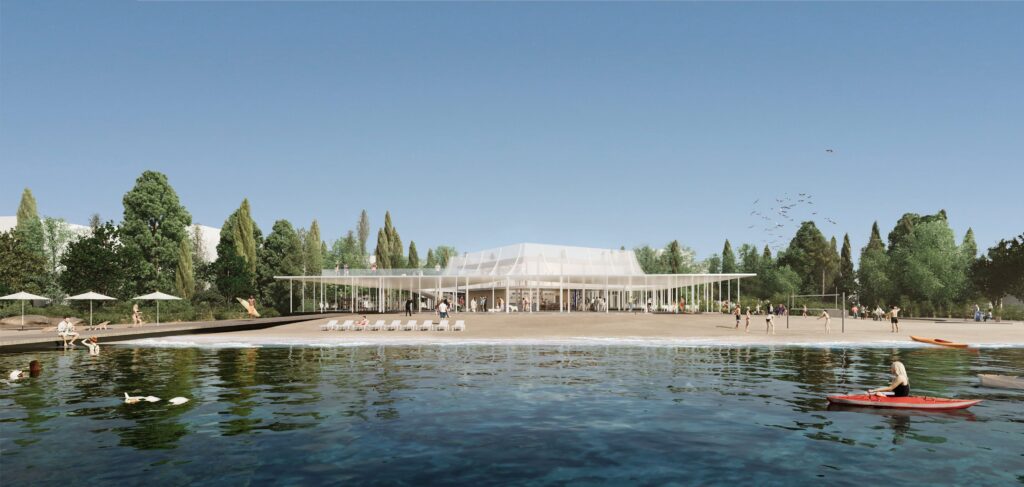
Ephemeral Horizons Nautical Club Renovation , 2024 © Collaborators: Jing Chen, Qizhen Tang, Yanci Chen
- What inspired you to pursue architecture, and how has your multicultural experience shaped your design philosophy?
My interest in architecture was born out of intrigue: how do spaces shape experiences and affect emotions? Growing up surrounded by different kinds of architecture, I became aware that buildings reflect cultural values, history, and social identity. This was an early realization that instilled in me the urge to design spaces that would serve more than functional needs but could narrate stories and strike a chord with people.
My multicultural experience brought up my design philosophy. International studying and working widened my view towards design; I see architecture as a universal language with limitless interpretations. Experiences in China, Japan, and the United States exposed me to approaches to form, materiality, and spatial arrangement that were different. Each had its unique perspective to teach me about the importance of harmonizing aesthetics with functionality and sustainability. The mix of such global insight has driven me to create designs that not only pay homage to cultural heritage but also meet modern needs, fashioning spaces that connect with people on both an emotional and intellectual level.
- How do you balance creativity with technical precision in high-stakes projects at Gensler?
It is truly a collaborative approach, disciplined planning, and crystal clear understanding of what the project is trying to achieve, elevated graciously. Creativity is critical in the envisioning process that characterizes truly innovative, inspiring spaces, while technical precision makes those ideas viable, safe, and in line with client expectations. I start off working with the team to explore ideas that are creative yet still make practical sense. By merging creative brainstorming with detailed technical reviews, supported by software such as Building Information Modeling, the ideas can be refined to both be pleasing but structurally sound. Routine collaboration with engineers and consultants can resolve issues early in the design process so that creative concepts remain technically viable and executable. This blend is crucial to impactful, high-quality designs, meeting standards of excellence that Gensler has come to expect.
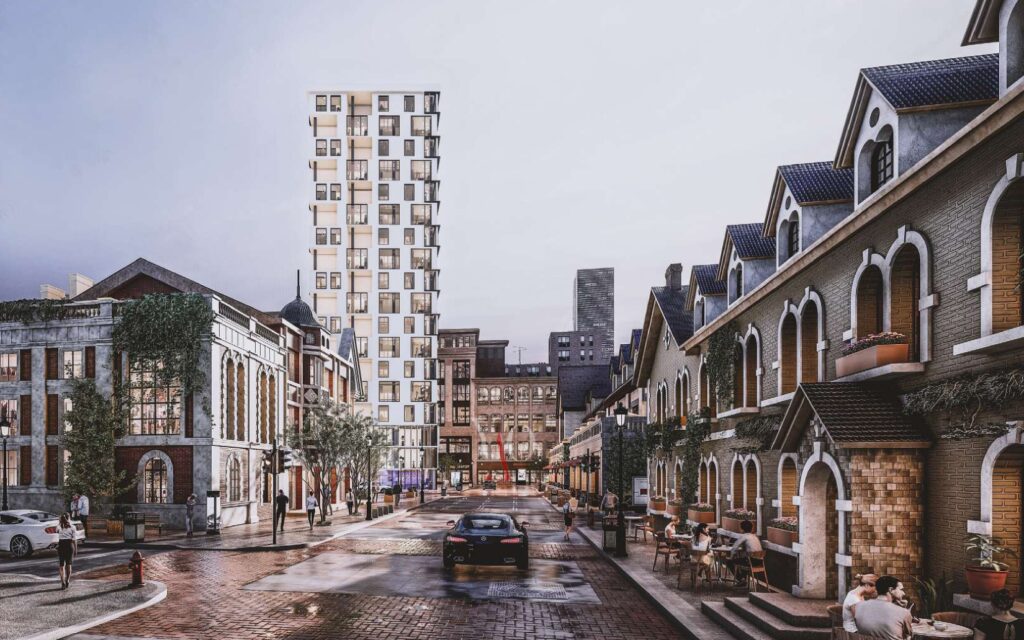
Future High Rise Residential Tower , 2024 © Yinzhu Yao
- Can you share more about your experience and approach in international design competitions and how they influence your daily design work?
International design competitions participation has transformed my creativity, adaptability, and collaboration. Most of the participation requires innovative solutions, as most of the challenges put forward by the case: for example, a cultural context of the working place, unknown tasks of the design brief, or tight deadlines. My philosophy remains bound to the diversities of the perspective-to always research the cultural and environmental aspects that identify the project. Another crucial point is to find competitions that align with one’s strengths and interests, allowing for the best showcase of individual talents. Choosing competitions that resonate personally can not only highlight the designer’s capabilities but also bring out their passion and dedication, making it easier to create meaningful and impactful designs. For example, if I am interested in projects concerning cultural heritage and architectural renovation, I try to participate more in those kinds of competitions. It is also worth observing the winners of previous years, because from that, one can gauge the style of the competition and the general quality level. High-quality competitions are more competitive, but the happiness and pride when winning is incomparable. Just today, I received the Honorable Mention in BLT Built Design Awards and literally jumped for joy!
This level of competition at the international stage helped to broaden my perspective on design thinking, making me agile and responsive towards various design challenges. I feel this influence in many ways in my daily work, as from there I received openness and adaptability in the same way as in this competition. Approaching any project, I take it as an opportunity to develop something new while keeping the design sensitive towards the needs and context of the client. The strategic thinking and creative exploration cultivated in these competitions create the continuing ability to formulate compelling, culturally relevant, and functional designs in my professional practice.
- Your photography has received significant acclaim. How does your work as a photographer inform or inspire your architectural designs?
While it comes to the formation of my view as an architectural designer, I can call photography the most influential medium. It was through the lens that I learned to see light, shadow, texture, and composition in a way that shaped deeply the way I approach design. Photography has further honed my eye to notice subtle details, patterns, and contrasts, which then I apply to the creation of visually impactful and emotionally resonating spaces.
Moreover, photography allows me to explore how people interact with spaces, and through this interaction, it teaches me about the way architecture can change the way people experience and feel. It is this very knowledge that instills in me the desire to design and create environments that are visually attractive but also engaging, vibrant, and interactive. The fact that I am a photographer enables me to capture moments and angles that would have otherwise gone unnoticed, and inspires me to design so that it evokes a sense of place, depth, and compatibility with their surroundings.
- Could you elaborate on how your participation in exhibitions, such as the “On the Critical Point” show at Penn Museum, complements your architectural practice?
Exhibitions such as “On the Critical Point” at the Penn Museum add another important layer to my architectural practice. Exhibitions allow ideas to move beyond the sometimes rigid bounds of a typical architectural project and be more conceptual and artistic. In the exhibition “On the Critical Point”, my work “AFTERMATH IN TRIPOLI” was invested with themes such as memory, place, and cultural identity-those very themes which also resonate deeply in architecture.
Exhibitions drive me to think about the story and emotional impact of space more critically, which I then take back to work into my architectural designs. They permit me to play with storytelling and symbolism, thus increasing my ability to design in communication with meaningful messages and emotionally touching users. I also feel that it exposes me to various artistic standpoints and critiques for growth and the evolvement of new ideas in the architectural projects I engage with. This brings me to practice with a more informed and cultured perspective that gives depth and intention to my designs.
It is an honor for my past works to be exhibited at the Penn Museum along with the Chinese Cultural treasures like Six Steeds of Zhao Mausoleum. Very coincidentally and fortunately. This work bears my original love of architecture, although not mature, but my exclusive memory.
- How does the ancient Chinese saying you resonate with influence your design goals, particularly regarding sustainability and cultural connection?
“为天地立心,为生民立命,为往圣继绝学,为万世开太平”. The ancient Chinese saying, “Establish the heart for heaven and earth, set destiny for humanity, continue the knowledge of past sages, and bring peace to future generations.
That, for me, translates in design to the creation of spaces that are functional but utmost respectful of the culture and ecological effects caused by one. I try to use sustainable material and design strategies that do the least harm to the Earth, which would mean “establishing the heart for heaven and earth.” I also try to conserve narratives of culture and create architecture that has something in common with the history of a place, enabling people to feel connected with their heritage and environment. This principle has inspired me to do architecture, which is beautiful but meaningful and sustainable, making a difference for generations to come.
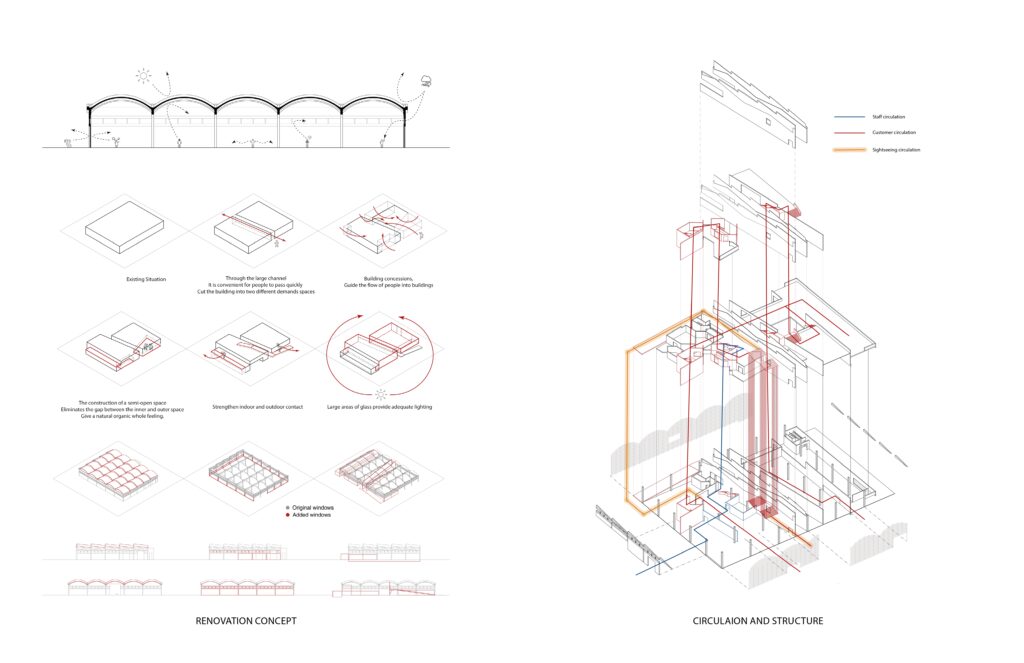
Experience bar: Factory Renovation, 2024 © Collaborator: Yixin Geng
- What role do you think architecture can play in addressing social issues and supporting disadvantaged communities, as you’ve expressed a commitment to?
I firmly believe that architecture could solve social problems, like dealing with the less privileged class. Thoughtful design can dramatically influence quality of life, and it produces places that inspire inclusiveness, dignity, and opportunity for everyone. Architecture is not about building buildings but about creating environments to meet diverse populations-especially underserved ones.
House designs that are more affordable through the utilization of open space can lend themselves to communication among people. Public spaces, such as libraries, community centers, and parks, are safe and accessible spaces for education, recreation, and connection. Even further, sustainable, affordable design solutions in low-income housing have the ability to reduce utility bills and lessen environmental impacts, benefiting the disadvantaged community. By allowing the community to be involved in this design process, architects can ensure those spaces will reflect the needs, values, and aspirations of themselves. I have come to see architecture as an enabling tool-a practice capable of yielding long-term social benefits and contributing to the closure of inequalities.
At the beginning of this year, I participated in the Kaira Looro 2024 International Architecture Competition. This organization focuses on architecture in rural African areas and on supporting disadvantaged communities, led by Kengo Kuma. This year’s theme was a maternal and child health center, and I was honored to be ranked in the Top 50. I plan to continue exploring and contributing to this field in the future.
- in your project “Performing the Oasis”, how does the concept of the “Cultural Thread” influence your design choices in connecting visitors with both historical and modern elements of the Shali Fortress?
This “Thread” guides our design, seamlessly connecting architectural spaces through time. We developed a curated tour route that transitions visitors from historical contexts to contemporary interpretations.
Our approach integrates existing paths into a cohesive journey. A newly designed tour path enhances appreciation for historical significance and provides an engaging experience. The thread guides visitors through key points of interest, fostering curiosity and deeper understanding of the site’s heritage.
Key features include Performance Areas, Exhibition Spaces, Multipurpose Spaces, and a Visitor Center. These facilities support diverse activities, enriching the overall visitor experience and ensuring the preservation of Siwa’s cultural heritage.
Our strategy emphasizes minimal intervention to safeguard authentic relics and ancient walls, employing lightweight, detached structures to maintain their original forms and materials.
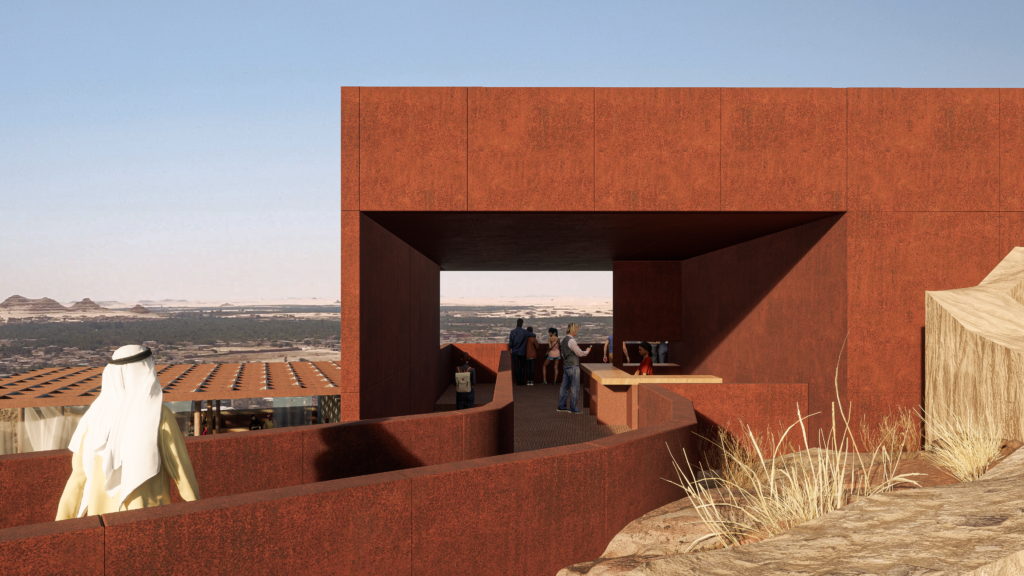
Oasis Performing and Heritage Exhibition Center, 2023 © Collaborators: Zhiqian Xu, Yongdi Li, Dingdong Tang, Zhaoxiong Han
- In your project “Experience Bar: Factory Renovation”, How did the central staircase design shape the flow and interactions within the bar, and what effect does it have on the visitor experience?
It sits center and front, serving not only functionally but also as a visual anchor to organically lead visitors through the space and into all aspects of it. Centrally positioned, it creates a dynamic circulation path for guests to meander around at different levels and adds to curiosity and discovery.
But more importantly, the staircase significantly increases visitor interaction. Its open, inviting design encourages people to pause, observe, and connect with others as they navigate their way through the space. The structure gives way to the ability to create community in the space, enabling guests to interact not only with the architecture but also others within it, elevating their experience. While the stairway supports flow within the bar, at the same time, it adds a layer of excitement and engagement to make the visit more interactive and memorable.
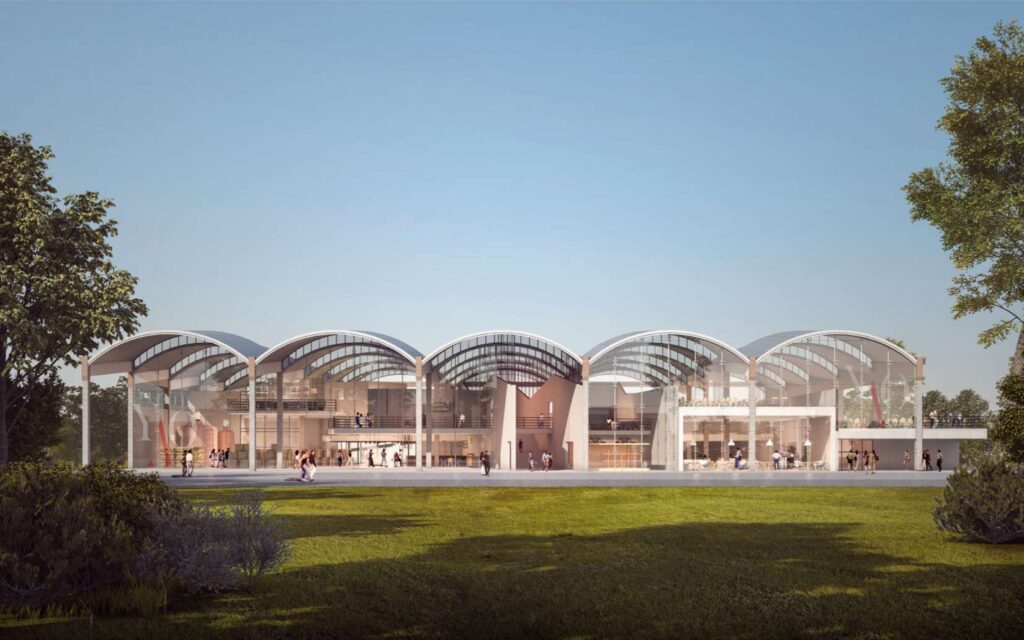
Experience bar: Factory Renovation, 2024 © Collaborator: Yixin Geng
- Looking ahead, what kinds of complex, impactful projects do you hope to lead, and how do your studies in engineering management fit into this vision?
I would like to be at the helm of leading such complex projects at pressing issues on societal levels, like sustainable urban development, adaptive reuse, and community-centered spaces. Projects that do not only push technical boundaries but create meaning and value in the communities, particularly under-resourced or historically significant areas, draw my attention. Such projects call for much more than design: strategic planning, collaboration across disciplines, and resources allocated with efficiency.
This vision also aligns with my studies in Engineering Management, since these studies equip me to take on the task of leading and coordinating large-scale projects effectively. Knowledge of project management principles, budgeting, and risk assessment enables me to view problems from a strategic perspective. Additionally, engineering management training brings a balance in that it marries my technical precision with creative problem-solving, making it possible to deliver projects that are innovative yet feasible. I believe this blend of architectural and managerial skills empowers me to take on highly impactful projects, bringing design, sustainability, and community needs together.
